October 7, 2025
Utility plans distributed storage installations at commercial and nonprofit sites to strengthen grid reliability and support clean energy growth

Xcel Energy is proposing a first-of-its-kind battery storage network across Minnesota — up to 200 MW of distributed storage resources that would be strategically placed on the grid by 2028. The project, called CapacityConnect, is designed to ease peak demand, improve grid efficiency, and accelerate the state’s transition toward cleaner, more reliable electricity.
Based on what Xcel has announced, this is an intriguing model that could be easily replicated by other utilities willing to modernize the grid and add flexible capacity fast. If approved by the Minnesota Public Utilities Commission, CapacityConnect would become one of the largest coordinated battery deployments by a regulated utility in the Midwest.
Distributed batteries as grid assets
Under the plan, Xcel Energy would partner with Sparkfund, a distributed energy resource (DER) deployment services company, to install modular battery systems — typically one to three MW each — at local businesses, nonprofits, and industrial sites. Each site host would receive direct payments for participating.
The batteries would be owned and operated by Xcel Energy and integrated into its system operations, charging when electricity prices are low and discharging during peak periods to help balance supply and demand.
“By storing energy when it’s cheap, delivering it when it’s needed most, and placing assets where they maximize grid value, Xcel Energy is delivering reliable energy to customers today and building a grid that is ready for tomorrow,” said Pier LaFarge, CEO of Sparkfund.
According to Xcel, each unit is roughly the size of a shipping container, and deployments would be spread across Minnesota to meet local grid needs while providing backup support for communities.
A new model for distributed capacity
Sparkfund, which has supported utilities with more than 3,200 distributed projects nationwide, will apply its Distributed Capacity Procurement (DCP) model — a planning and delivery framework that treats DERs as system resources rather than pilot programs.
“Distributed energy resources are ready to take on a larger role in capacity planning,” LaFarge said. “This model allows utilities to deploy at the scale and speed necessary to meet load growth while unlocking the full value of the grid.”
Xcel Energy’s proposal to the Minnesota PUC will outline how the company intends to evaluate performance, cost, and customer experience as the storage network expands. The company expects to complete its initial 200 MW rollout by 2028.
Aligning with Minnesota’s 600 MW storage goal
Battery storage is a cornerstone of Xcel Energy’s Upper Midwest Energy Plan, which calls for 600 MW of storage by 2030. The CapacityConnect initiative represents a third of that total and introduces a decentralized approach: small-scale batteries that can serve both customer sites and the larger grid.
“We’re focused on supporting economic growth and the needs of our communities by building out and modernizing our energy grid,” said Ryan Long, president of Xcel Energy–Minnesota, North Dakota, and South Dakota. “Distributed energy resources will complement our current plans for additional renewable and firm dispatchable generating resources to meet our customers’ needs.”
Xcel says the program would also prioritize workforce development and local job creation, adhering to the company’s labor standards and safety protocols.
Why it matters
By placing batteries near demand centers, utilities can defer expensive substation or transmission upgrades, reduce stress during extreme weather, and deliver more equitable access to clean energy benefits. If implemented, Xcel’s approach could serve as a model for other states exploring hybrid centralized–distributed grid modernization strategies.
Tags: commercial and industrial











